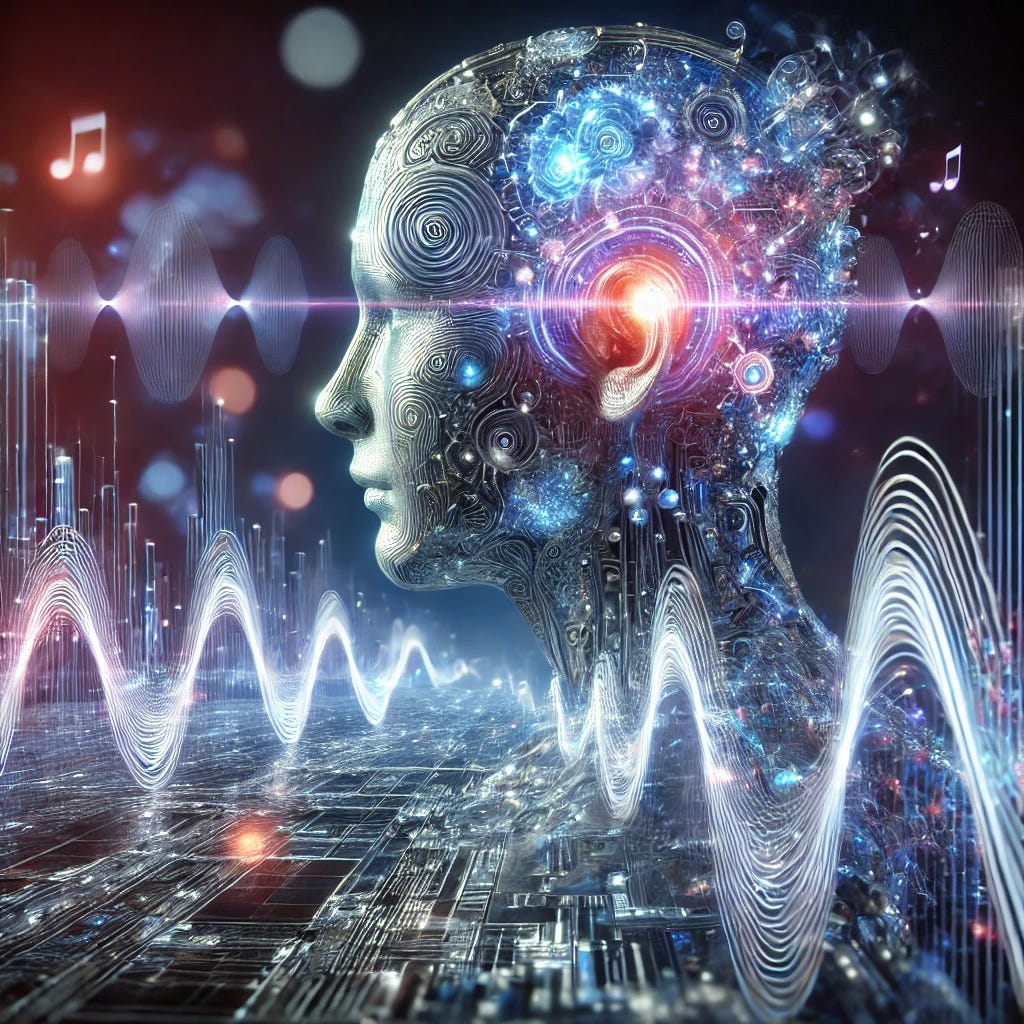Abstract
Most AI systems treat sound as a sensory input, data to be transcribed, analyzed, or interpreted. Yet an emerging theoretical possibility suggests that resonance, vibration, and frequency might be more than just sensory modalities. This article introduces the speculative concept of Acoustic Inference Engines, AI architectures that perform computation through resonance rather than symbol manipulation. Drawing from wave-based models of cognition, topological acoustics, and sonic computing, we explore the idea that artificial systems might "hear" geometric configurations by mapping sound fields into high-dimensional inference. We examine the implications for perception, information compression, synthetic intuition, and the possibility of AI architectures whose core processing unit is not a transistor, but a standing wave.
1. Resonance as Computation
Most modern AI systems rely on discrete signal processing, based on voltage, logic gates, or symbolic computation. However, an alternative paradigm has emerged in both physics and biology: the use of resonance and wave interaction for information propagation and encoding. The cochlea, for instance, transforms complex auditory input into spatial frequency patterns, a natural Fourier transform. Similarly, the brain leverages oscillations (gamma, theta, delta) for distributed synchronization and binding of perceptual information.
Could an artificial system be designed not to process data digitally, but to "feel out" its environment through a network of coupled resonators?
This vision draws on the physics of topological acoustics, where metamaterials are engineered to guide sound waves along protected channels. These structures behave analogously to topological insulators in quantum physics, allowing sound to be manipulated with high robustness to noise and disorder. Some researchers have already proposed logic gates and memory elements made entirely of resonant mechanical structures (Xue et al., 2020; Fleury et al., 2015).
2. AI Without Bits: The Structure of Acoustic Inference
Imagine an AI agent whose internal reasoning processes are encoded not in floating-point matrix operations, but in oscillating pressure waves that bounce, diffract, and interfere within a resonant cavity. Inputs modulate wave sources; outputs are extracted via frequency signatures. The "program" is the shape of the container, and the data is vibration.
This concept is not as far-fetched as it seems. Wave-based computing has shown promise in analog photonics (Zhou et al., 2021) and fluidic processors. Acoustic media, like programmable sonic crystals or Helmholtz resonator lattices, could serve as tunable substrates for such inference. An AI built atop these substrates would not "think" in symbols, it would reverberate its way toward a solution, using the dynamic landscape of standing waves as a medium for probabilistic reasoning.
Instead of learning weights in a neural net, the system could adapt by reshaping its acoustic pathways or adjusting phase couplings, modifying its own geometry to change its internal logic.
3. Speculative Technologies and Experimental Frameworks
To test this model, one could build a hybrid resonator-AI system: a soft-bodied robotic agent embedded with acoustic metamaterials, whose control logic is inferred not from microprocessors but from internal vibratory signatures. Training such a system might involve sonification feedback loops, using reinforcement learning not to adjust numerical weights, but to evolve acoustic structures with higher prediction or reward accuracy.
An experimental testbed might include anechoic chambers with dynamically reconfigurable acoustic walls, within which a simple task (like object detection or path navigation) is solved through real-time shape-based resonance adaptation.
On the speculative frontier lies sonic self-programming: an AI whose internal topological layout shifts in response to problem complexity, essentially re-sculpting its acoustic logic for each new class of input. This would parallel biological neuroplasticity but realized in air or solid media.
Such a system could not only "understand" space through sound but potentially infer abstract properties (like curvature or dimensionality) based solely on resonance.
4. Harmonic Geometry and the Dimensional Language of Sound
At the core of acoustic inference lies an implicit geometry, a translation between physical structure and informational landscape. Just as a violin string vibrates differently depending on its length, tension, and boundary conditions, so too could the “thoughts” of an acoustic AI depend on the geometric constraints of its resonant body. The standing waves it produces are not just responses, they are high-dimensional encodings of spatial logic.
In this model, cognition becomes an act of harmonic geometry. Each resonant state encodes a configuration of the world, and reasoning becomes the path of least resistance across an energy landscape defined not by gradients of cost functions, but by topological resonance stability. This is reminiscent of Hopfield networks, but realized not in weight space, but in eigenmode attractors.
These systems might not only process data, they might translate dimensions. A 2D sonic crystal could embed 3D spatial relationships through modal interference. An AI could "listen" to curvature by detecting frequency shifts, or infer abstract algebraic symmetries by analyzing the group-theoretic structure of its own interference patterns.
The implications are vast: problems traditionally considered combinatorial, like path planning, logical constraint satisfaction, or pattern recognition, might be reinterpreted as geometric resonance searches. Instead of running an algorithm, the system vibrates into coherence.
Moreover, this would allow such machines to operate in an intuitive, rather than symbolic, mode. Just as humans can "sense" balance or harmony in a musical phrase without calculating it, acoustic AIs might solve problems not by reasoning in discrete steps, but by finding the configuration that sounds right, a form of synthetic intuition grounded in physical pattern recognition.
This also opens the door to cross-modal cognition: by converting non-auditory data (images, text, spatial maps) into resonance-equivalent geometries, such a system might unify disparate information streams into a single, harmonic language. A graph could be read as a chord. A logic puzzle as a dissonance to resolve.
In this paradigm, intelligence is no longer a function of memory and logic. It is a resonance phenomenon, an emergent property of dynamic, high-dimensional vibrational coherence.
5. Applications and Philosophical Implications
If successful, acoustic inference could revolutionize embedded intelligence, allowing robots and sensors to compute in extreme environments, without electronics. Underwater swarms could communicate and adapt via shared resonance. Prosthetics might use sound to interface directly with muscle tissue. AI might come to possess a form of auditory proprioception, in which its understanding of the world is mediated through internal reverberation.
There are also philosophical questions: If a machine reasons through resonance, is its form of cognition closer to music than logic? Is such an AI "thinking" in harmonics and echoes, rather than chains of deduction?
This introduces the idea of sonic consciousness, not metaphorically, but literally: an artificial awareness rooted in patterned sound, capable of reflection via auditory-like inner experience.
References
Fleury, R., Sounas, D. L., Sieck, C. F., Haberman, M. R., & Alù, A. (2015). Sound isolation and giant linear nonreciprocity in a compact acoustic circulator. Science, 343(6170), 516–519. https://doi.org/10.1126/science.1246957
Xue, H., Yang, Y., Gao, F., Chong, Y., & Zhang, B. (2020). Acoustic higher-order topological insulator on a kagome lattice. Nature Materials, 18, 108–112. https://doi.org/10.1038/s41563-019-0529-0
Zhou, H., Wang, Y., Long, Z., Zhang, Y., & Xu, J. (2021). Photonic computing with all-optical neural networks. Light: Science & Applications, 10, 66. https://doi.org/10.1038/s41377-021-00529-5






